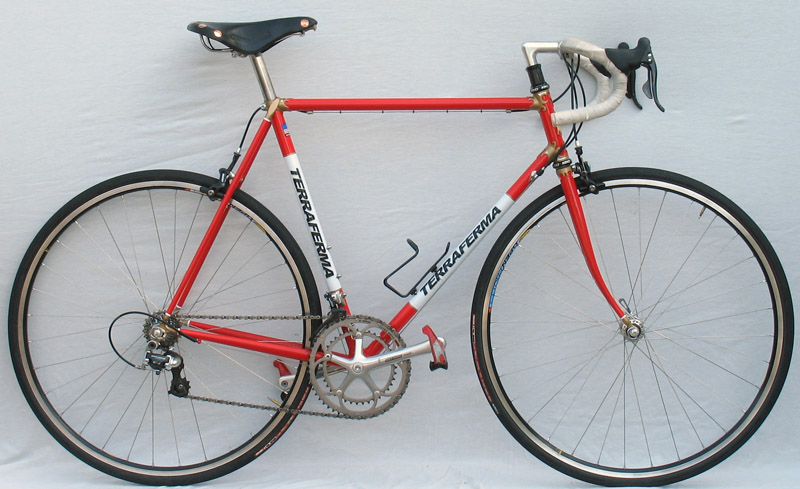A Journey of Discovery, Part 5: Frame Stiffness

In the previous parts of this series, we have looked at how our preferences in bicycles changed over time. We started out on “state-of-the-art” bikes with mid-trail geometries, 700C x 28 mm tires and saddlebags. How did we come to prefer low-trail 650B bikes with much wider tires and handlebar bags? And is habituation stronger than optimization? In other words: Do riders prefer the bikes they usually ride, or are there bikes that really are superior, even if they are unfamiliar?
Both Mark and I never had cared much about frame stiffness. Then we tested a few bikes with oversize tubing and relatively thick walls. We were baffled by their relatively poor performance. It was framebuilders and constructeur Peter Weigle who suggested: “Maybe those frames are too stiff for you.” After a lot of thinking and even more riding of different bikes, I hypothesized that relatively flexible frames were easier to pedal, because they did not resist our pedal strokes. We could get in sync with the frame, pushing down harder during the power stroke. The frame stored the excess energy as it flexed, and returned it to the drivetrain during the “dead spots” at the top and bottom of the stroke.
I compared the phenomenon to a boat rising out of the water at a certain speed – “planing.” At a certain power output, some bikes felt easier to pedal even though I was going faster than before. Mark was skeptical. He was unwilling to give up the belief that frame stiffness did not matter at all.
Mark and I both agreed that a classic Columbus SL/Reynolds 531C frame offered a great ride. After all, how could decades of racers be wrong? Both my Singer and Mark’s new bike used those tubes, and we liked these bikes a lot.

Then came the first Terraferma test bike (above). It was a racing bike. I didn’t know anything about the tubing. The bike wasn’t particularly light. I didn’t find it very appealing at first, but I was surprised when I felt faster than usual when riding it. Was there something special about this bike, or did I just have a particularly good day when I rode the Terraferma?
To better assess the performance of our test bikes, Mark and I ride a loop around the north end of Lake Washington that has several long, sustained climbs. We usually are well-matched in our climbing speeds. On this day, Mark started on the test bike, while I was on my Singer. I was careful not to let on to Mark what I thought about the test bike to avoid biasing his judgment.
On the first long hill, I accelerated in two stages. As usual, Mark remained on my wheel for the first acceleration. When I looked back after upping the pace again, I couldn’t see Mark behind any longer. “Wow,” I thought, “Mark is gone. That test bike is not very fast after all.” Then I realized that Mark was in the blind spot on my other side, passing me. He shifted into a higher gear, and let out a laugh as he accelerated up the hill. Try as I might, I could not catch him.
Then we switched bikes, and it was Mark who was dropped, riding my Alex Singer. We added weight to the Terraferma, and it still was faster. So we hypothesized that it used lighter, more flexible tubing that made it “plane” better. I called Mike Terraferma, and he confirmed that the bike was made from “superlight” tubing, with walls that were about 0.1 – 0.2 mm thinner than those of the bikes we ride all the time. And Mark wrote an article for Bicycle Quarterly titled: “Confessions of a Lapsed Skeptic on Planing.”
We later conducted a double-blind test of three frames: two superlight and one from tubing like the bikes we usually ride (see photo at the top). The results confirmed what we had observed on the Terraferma: For Mark and I, the bikes with the superlight tubing were easier to pedal without our legs hurting during all-out efforts. We could go faster on them. (Our third tester could not tell the relatively small difference between the bikes.)
Both Mark and I were faster on the superlight bikes, even though the “standard” bike was very similar to the bikes we had ridden (and continue to ride) all the time. So from our experience, it appears that there is an “optimal” configuration out there. Of course, the optimum may vary depending on what you want to do with your bike.
That doesn’t mean that other bikes are no fun to ride. Both Mark and I still have the bikes we ordered in 1999. They still do everything we wanted them to do back then. However, we have found that we can ask much more of a bike than we ever thought possible.
Click here to go to Part 6 of this series.
Click here to start reading with Part 1 of this series.
Further reading:
– Double-blind tests of frame stiffness and planing, Bicycle Quarterly Vol. 6, No. 4.


